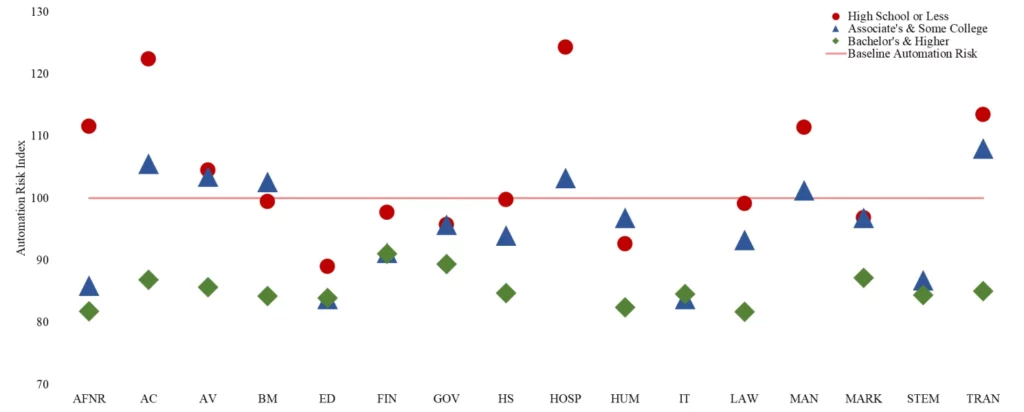I’ve been on ChatGPT a lot lately and—apparently—I’m not the only one. I’m not actually using it (though I intend to); I’m there to gawk over what it can do—and, spoiler, it goes well beyond producing first-year term papers. At a recent social gathering, one of my colleagues demonstrated that—if given a fictional research question—the generative artificial intelligence behind ChatGPT can write nearly flawless computer code for a certain syntax-based statistical package commonly used among policy-researcher types, like myself. It was humbling; I’ve spent years learning to write such code, to middling ability. As you might imagine, this demonstration led to some inevitable—and now ubiquitous—hand-wringing about automation and the implications for society.
After Career and Technical Education (CTE) month in February, my mind naturally returned to an area of inquiry I’ve had for some time now: To what degree can automation affect the career outcomes of graduates of CTE programs? I’ve done some preliminary digging and have an idea, but a quick CTE primer is a useful starting point.
Today’s “career and technical education” is yesterday’s “vocational education,” though not really. Like previous iterations, contemporary CTE focuses on equipping high school and community college students with technical skills that are closely tethered to specific workforce applications—think carpentry or plumbing. By contrast, courses and programs within the “academic” curriculum emphasize subject-matter knowledge and the development of broadly applicable skills—think history, science, language studies, etc.
Modern-day CTE advocates would argue the similarities to former vocational education models end there, however, and would likely (and rightly) assert that making the “academic” versus “vocational” education distinction is a bit anachronistic given the college- and career-readiness movement, and material changes to federal CTE legislation have, over time, successfully blurred the lines between the two. There’s a collective (and bipartisan!) sense that these changes have steered CTE in a positive direction, toward “relevance and rigor,” and away from its “dark history” of tracking disadvantaged students into low-wage, low-opportunity occupations.
My recent ChatGPT experience has me wondering about this consensus opinion, however. Let me explain.
To begin, jobs requiring skills that are difficult to automate with available technologies are at lower risk of automation. These skills include things like two-way communication, critical thinking, creativity, planning, management, and problem-solving. These are transferable skills, not technical skills. Career and technical education courses and programs need to equip students with both. Not only will the combination of technical and transferable skills help CTE students compete for the automation-resilient jobs of today (which tend to require bachelor’s degrees), the combination will give them greater agility when automation threats come knocking tomorrow.
This shouldn’t be a stretch; a key element of contemporary, “rigorous and relevant” CTE is a push to better integrate academic content within technical learning contexts. The concern I have is that “academic integration” is mostly open to interpretation, and there’s not a lot of guidance for how to do it well across the16 different trades-based (e.g., Architecture & Construction, and Manufacturing), service-based (e.g., Education & Training and Human Services) and tech-based (e.g., Information Technology and Science, Technology, Engineering and Mathematics (STEM)) CTE fields of study or “career clusters.” There’s also little accountability for academic integration baked into federal policy. Consequently, states, districts, schools, and teachers take different approaches to academic integration, and some approaches are more successful than others.
The importance of—and challenges to—carving out space in every CTE classroom in every CTE career cluster for the development of transferable, nontechnical skills becomes especially salient when you analyze automation risks across the different CTE career clusters. To do this, I merged Bureau of Labor Statistics (BLS) Occupational Employment and Wage Statistics (OEWS) data with an available automation-risk index that assigns each occupation an individual risk score. This particular index has a base of 100; occupations with a score above this base have higher risks of automation, and occupations below the base have lower risks of automation. I calculated the average automation risk (weighted by total 2019 employment) for each CTE career-cluster area by entry education level (see Figure 1). Several things stand out.

Note: AFNR = Agriculture, Food & Natural Resources, AC = Architecture & Construction, AV = Arts, A/V Technology & Communication, BM = Business Management & Administration, ED = Education & Training, FIN = Finance, GOV = Government & Public Administration, HS = Health Science, HOSP = Hospitality & Tourism, HUM = Human Services, IT = Information Technology, LAW = Law, Public Safety, Corrections & Security, MAN = Manufacturing, MARK = Marketing, STEM = Science, Technology, Engineering & Math, TRAN = Transportation, Distribution & Logistics. Source: Bureau of Labor Statistics Occupational Employment and Wage Statistics.
First, average automation risks decrease as education level goes up, largely because jobs requiring bachelor’s degrees involve a greater number of transferable skills that are less easy to automate. Second, some CTE career-cluster areas have average automation risks that are low: Education & Training, Health Sciences, Information Technology, and Science, Technology, Engineering and Math. Other CTE career-cluster areas have automation risks that are high: Architecture & Construction, Hospitality & Tourism, Manufacturing, and Transportation, Distribution & Logistics. Third, the gap between the lowest and highest levels of education is greatest in clusters with the highest aggregate automation risk, which suggests the academic-integration hurdle is higher in these clusters compared with others.
All this matters because existing research indicates CTE participation can be stratified by race, gender, income, and rurality. Consequently, some student groups may be overrepresented in at-risk clusters. In other words, exposure to automation risk can be correlated with student characteristics. And if our efforts to equip these students with automation-resilient, transferable skills are not successful in these clusters, we risk the possibility of, once again, funneling disadvantaged students into low-wage, low-opportunity occupations. CTE’s “dark history” becomes its future.
Can contemporary CTE shield students against risks posed by automation? Absolutely. In theory, CTE students should be better prepared for automation. The pieces are there; done right, academic integration, work-based learning, the Comprehensive Local Needs Assessment, and apprenticeship models can work to close the gap between the skills students have and the skills employers need, today and tomorrow. And the “special populations” set-aside now within federal CTE legislation that requires providers to allocate funds toward recruiting low-income, disabled, and racially marginalized students into CTE should help diversify cluster pipelines and mitigate tracking. It’s always been important to get these things right, but the arrival of ChatGPT means it’s now more important than ever.

